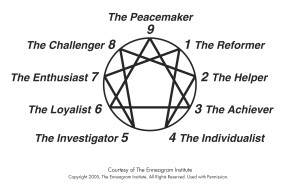Enneagram
(Courtesy of the Enneagram InstituteCopyright 2005. The Enneagram Institute. All Rights Reserved. Used with Permission.)
The Enneagram is both a rich framework for understanding human personality and for guiding spiritual growth. The roots of the system are said to be ancient, although much of the psychological foundation was laid by two South Americans (Oscar Ichazo and Claudio Naranjo) in the twentieth century. “Ennea-“ means 9 in Greek, and the diagram has 9 points which represent personal patterns, perspectives, points of view, coping strategies, ways of being in the world. Each of these patterns contains both a gift and a potential limitation.
There are numerous contemporary authors and teachers of the Enneagram and several “schools” with their own variations – plenty to draw from. And lest one should be fooled into thinking the system is simple, I should say that there are also numerous layers of complexity and subtlety beneath the surface of the basic diagram.
I find that it can be useful for clients to identify and learn more about their “point of view” as a way of understanding themselves more deeply, recognizing both their strengths and their challenges in a more objective way. Although I use the word “understanding,” the process is far from purely intellectual or rational: there are often deep emotional and even somatic reverberations as the exploration proceeds from the surface information to deeper dimensions of self-recognition. The literature also offers indications of useful practices and directions for growth.
This personality-based approach has great value – and not everyone is interested in it! I may offer some introductory information to see if it captures a client’s interest and curiosity – and if it doesn’t, that’s just fine.
The Enneagram may also be approached as a lens that contributes to spiritual growth. In understanding our core patterns, we may come to see that they are what we have and not what we are in essence. As awareness of the patterns becomes more and more available, we may find ourselves identifying less with the personality – and more often resting in and as the freedom and spaciousness of awareness itself.

